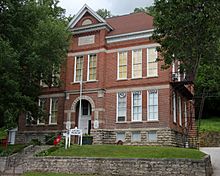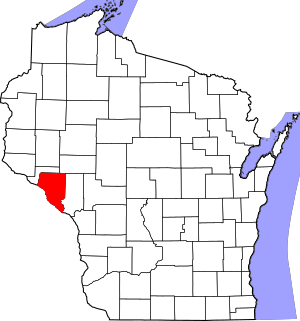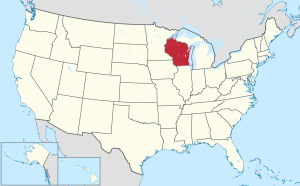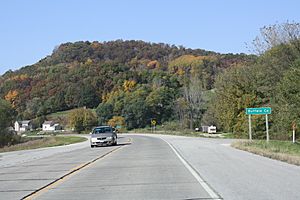Buffalo County, Wisconsin facts for kids
Quick facts for kids
Buffalo County
|
|
|---|---|

Alma Area Museum in Old Buffalo County Training School and Teachers College Building in Alma, Wisconsin.
|
|

Location within the U.S. state of Wisconsin
|
|
 Wisconsin's location within the U.S. |
|
| Country | |
| State | |
| Founded | 1854 |
| Named for | Buffalo River |
| Seat | Alma |
| Largest city | Mondovi |
| Area | |
| • Total | 710 sq mi (1,800 km2) |
| • Land | 672 sq mi (1,740 km2) |
| • Water | 38 sq mi (100 km2) 5.3% |
| Population
(2010)
|
|
| • Total | 13,587 |
| • Estimate
(2020)
|
13,033 |
| • Density | 19.14/sq mi (7.39/km2) |
| Time zone | UTC−6 (Central) |
| • Summer (DST) | UTC−5 (CDT) |
| Congressional district | 3rd |
Buffalo County is a county located in the U.S. state of Wisconsin. As of the 2010 census, the population was 13,587. Its county seat is Alma. The county was created in 1853 and organized the following year.
Contents
History
Buffalo County, founded in 1853, is named for the Buffalo River, which flows from Strum to Alma, Wisconsin, where it empties into the Mississippi River. The Buffalo River obtained its name from the French voyager Father Louis Hennepin, who named it "Riviere des Boeufs" in 1680. The first permanent settlement was established in 1839, located in what is now Fountain City. This settlement was originally named Holmes' Landing after a family that traded with the Sioux and Chippewa. Buffalo County was settled primarily by Swiss, German, and Norwegian immigrants who were drawn to the area by the growing lumber industry, fertile soils, access to the Mississippi, and available land. By 1848 a second community was established called Twelve Mile Bluff, which is now known as Alma.
Agriculture developed during the 1850s on top of the ridges where there were natural prairies and oak savannas, which made working the land much easier. With the lack of good roads, settlement remained along the Mississippi River where farmers could ship their grain on steamboats. The development of the Northern Rail from Winona, Minnesota allowed for development away from the river, and by 1890 farmers were transporting their goods predominantly by rail.
The Civil War gave a boost to the local economy with the rising demand for wheat, which was the main crop of the county. The post-war period brought a large influx of settlers, however, because of declining soil fertility, many moved west rather than adopt crop rotation and fertilization. With the price of wheat falling, farmers turned to dairy farming, and by the 1880s local creameries had started to appear.
Geography
According to the U.S. Census Bureau, the county has a total area of 710 square miles (1,800 km2), of which 672 square miles (1,740 km2) is land and 38 square miles (98 km2) (5.3%) is water.
Adjacent counties
- Pepin County – north
- Eau Claire County – northeast
- Trempealeau County – east
- Winona County, Minnesota – south
- Wabasha County, Minnesota – west
Major highways
Demographics
| Historical population | |||
|---|---|---|---|
| Census | Pop. | %± | |
| 1860 | 3,864 | — | |
| 1870 | 11,123 | 187.9% | |
| 1880 | 15,528 | 39.6% | |
| 1890 | 15,997 | 3.0% | |
| 1900 | 16,765 | 4.8% | |
| 1910 | 16,006 | −4.5% | |
| 1920 | 15,615 | −2.4% | |
| 1930 | 15,330 | −1.8% | |
| 1940 | 16,090 | 5.0% | |
| 1950 | 14,719 | −8.5% | |
| 1960 | 14,202 | −3.5% | |
| 1970 | 13,743 | −3.2% | |
| 1980 | 14,309 | 4.1% | |
| 1990 | 13,584 | −5.1% | |
| 2000 | 13,804 | 1.6% | |
| 2010 | 13,587 | −1.6% | |
| 2020 (est.) | 13,033 | −4.1% | |
| U.S. Decennial Census 1790–1960 1900–1990 1990–2000 2010–2020 |
|||
As of the census of 2000, there were 13,804 people, 5,511 households, and 3,780 families residing in the county. The population density was 20 people per square mile (8/km2). There were 6,098 housing units at an average density of 9 per square mile (3/km2). The racial makeup of the county was 98.69% White, 0.12% Black or African American, 0.30% Native American, 0.33% Asian, 0.02% Pacific Islander, 0.08% from other races, and 0.46% from two or more races. 0.62% of the population were Hispanic or Latino of any race. 44.3% were of German, 22.1% Norwegian and 8.8% Polish ancestry. 96.9% spoke English, 1.6% Spanish and 1.1% German as their first language.
There were 5,511 households, out of which 30.80% had children under the age of 18 living with them, 58.90% were married couples living together, 6.20% had a female householder with no husband present, and 31.40% were non-families. 27.10% of all households were made up of individuals, and 12.60% had someone living alone who was 65 years of age or older. The average household size was 2.47 and the average family size was 3.01.
In the county, the population was spread out, with 25.10% under the age of 18, 6.90% from 18 to 24, 27.60% from 25 to 44, 23.70% from 45 to 64, and 16.80% who were 65 years of age or older. The median age was 39 years. For every 100 females there were 100.70 males. For every 100 females age 18 and over, there were 101.40 males.
Communities
Cities
- Alma (county seat)
- Buffalo City
- Fountain City
- Mondovi
Villages
Towns
Census-designated places
Other unincorporated communities
Ghost towns
Notable people
- Chauncey H. Cooke (1846–1919), American soldier in the U.S. Civil War
See also
 In Spanish: Condado de Buffalo (Wisconsin) para niños
In Spanish: Condado de Buffalo (Wisconsin) para niños



